
General Pervez Musharraf and I are peers in a curious way, though we have never met. There have been many interesting and some coincidental events in our lives. We were both born in India in the 1940s against the backdrop of the Second World War, when we were still a colony of the British Empire. We came from middle-class families that were on the wrong side of the border when the country was partitioned in 1947. The Musharraf family migrated from Delhi to Karachi, and my ancestors moved in the opposite direction, from Rawalpindi to Patiala. Both families faced untold hardships as refugees or mohajirs as they were called in Pakistan, and still are! The experience of growing up in nascent nations that had fought a war over Kashmir in 1947–48, was shaping our young minds. We joined our respective military academies in 1961, and also got commissioned in the same year – 1964. Adventurous and fond of the outdoors, we have both been fairly skilled marksmen. As youngsters, we fancied Bengali damsels, but unlike Musharraf, mine was a briefer friendship as recounted in Part II.
From what I have read, Musharraf got married in 1968 to Sehba Farid, a pretty and talented young lady. It was an arranged marriage. They have two children, a girl and a boy.
I was also a captain when I was married, albeit in a different fashion. I met and fell in love with an attractive young girl of nineteen at the ‘New Year’s Eve’ dance at the Army Club in Poona. Two months later, we were engaged, and got married in May 1971. We also have two children, a boy and a girl.
THE RAISON D’ETRE OF A SOLDIER

Medals earned by my grandfather, Sep Atma Singh, 1/67 Punjab Regt–World War I, Mesopotamlan Campaign, 1914–1918.

Medals earned by my father, Lt Col J.S. Marwah (EME) - Second World War and the Indo-Pak wars, 1943–1973.

My decorations and medals, 1964–2007.
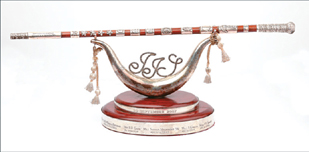
My baton with crested silver bands of all command assignments – the widest band representing the command of 9 Maratha LI.

With the ladies of Adi and Memba tribes of Upper Siang district during a tour to interior areas at Tuting in Arunachal Pradesh, 19 February 2009.

Prime Minister waving to the crowd with (from left to right) Union ministers Prithviraj Chavan and Mani Shankar Aiyar, Chief Minister Dorjee Khandu and I at the Indira Gandhi Park, Itanagar, 31 January 2008.
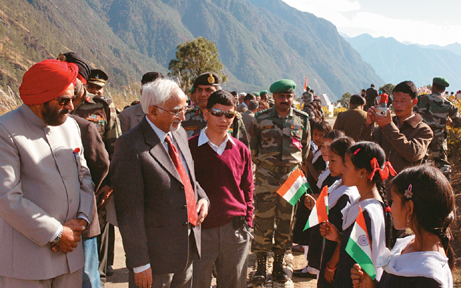
With Vice President Hamid Ansari and Minister Kalikho Pul at Kibithoo, Anjaw district, on 27 November 2008.

Inaugurating the Singa micro hydel project near the China border, February 2009. Rohini and I in Memba dress flanked by ADC Ravi Gonte, Aloke Dutt, former chief minister Gegong Apang, Prashant Lokhande and others.
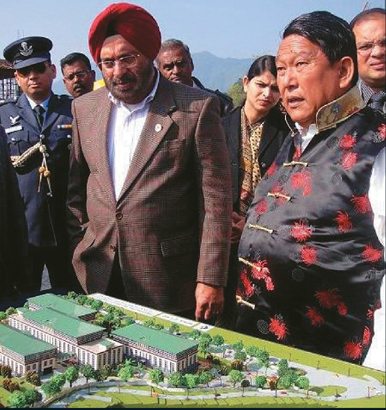
Reviewing the progress of State Secretariat Complex along with Chief Minister Dorjee Khandu, Itanagar, 4 January 2011.

Addressing the state legislative assembly on 3 March 2011. In the chair is Speaker Wanglin Lowangdong and seated in front row (right to left) are Chief Minister Dorjee Khandu (In white shirt), and ministers Jarbom Gamlin, Nabam Tuki and Tako Dabi.
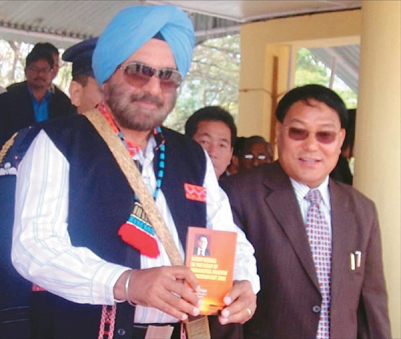
Releasing a book on the Arunachal Education Act 2010 by Minister Bosiram Siram, February 2011.

Near the border at Taliha, flanked by ministers Chowna Mein and Tanga Byaling.
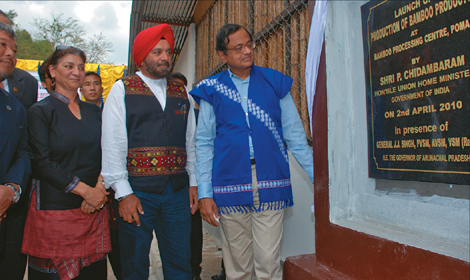
Home Minister P. Chidambaram inaugarating a bamboo processing centre at Poma, near Itanagar, on 2 April 2010.
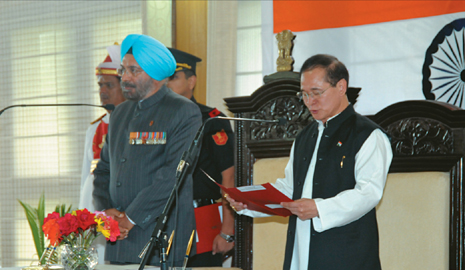
Swearing In of Arunachal Chief Minister Nabam Tuki on 1 November 2011.

After the swearing in of Chief Minister Nabam Tuki (second from left). With Dr (Col) D.R. Shandil, Mrs Tuki, Rohini and Union minister S.K. Shinde, Itanagar, November 2011.

Rohini and I along with family and friends after rafting In the Sum In Ladakh, 2009.

Rohini and I with Kuljit and James, our foster children, at Army House, New Delhi, 2007.
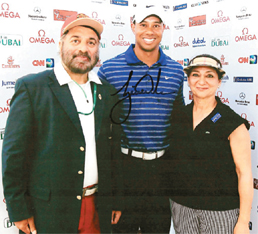
With Tiger Woods, Dubai Desert Classic, 2009.
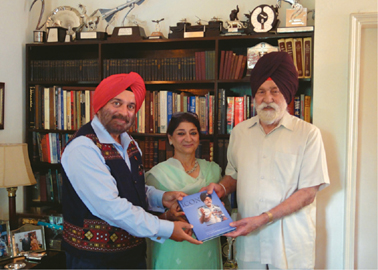
With Marshal of the Air Force Arjan Singh, DFC on 16 July 2011.
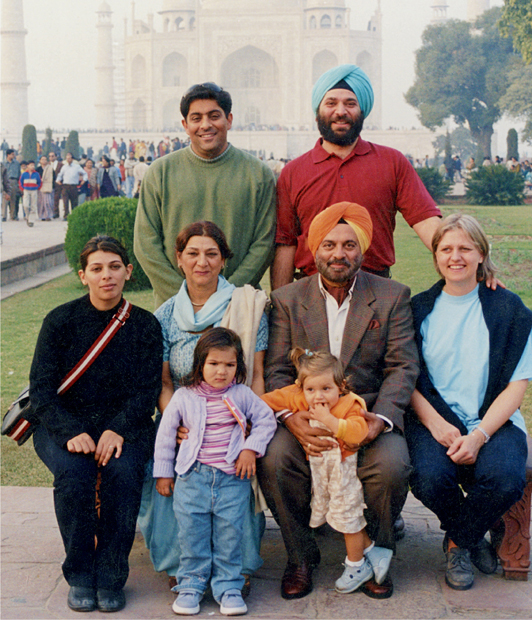
Taj Mahal, Agra, 2001. Sitting: Sonia, Rohini, I, Anna, with Seerat and Anne-Tara. Standing: Gagan and Vivek.
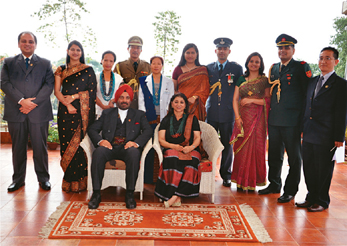
Team Arunachal, Itanagar, 2012: Sitting: Rohini and I; Standing (left to right): Ankur Garg, Swati Sharma, Tage Napi, Tage Habung, Dr T. Kampu, Monika Punia, Sqn Ldr Rajesh Punia, Dr Tripti Dabral, Maj Kuldeep Dabral, Atum Potom.
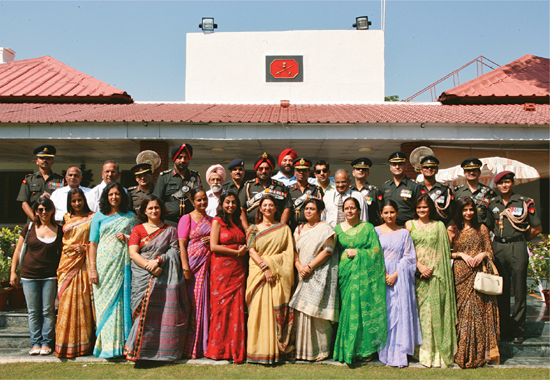
The Jangi Laat’s (army chief’s) team, Army House, 2007.

Family reunion on my father’s 90th birthday, July 2011.
After doing the staff college we both held the prestigious post of brigade major and subsequently, commanded our battalion/regiment. Both of us served in our respective Army HQs in the military operations directorate, in senior capacities. Later, as lieutenant generals, both Musharraf and I commanded the elite 1 Corps of Pakistani and Indian armies respectively. We are survivors, too: I was shot and seriously wounded by terrorists in Kashmir, and his car was blown up by a terrorist’s bomb, and both of us have had a few more close brushes with death.
Finally, we became the army chiefs of our respective countries, and held this coveted appointment during the period 2005–07, though Musharraf had also appointed himself as the president after a coup in 1999. I retired on 30 September 2007, and was appointed by my government as the governor of Arunachal Pradesh in January 2008. In the case of Musharraf, though he reluctantly doffed his uniform in 2007, he continued wearing his other hat – that of the self-appointed president of Pakistan. Sadly for him, from that dizzy height, he had to step down unceremoniously on 18 August 2008, as he had been served an ultimatum by the political coalition that was then ruling Pakistan to resign by 19 August or face impeachment. What an inglorious end to his innings as the head of state! He lives in London these days, and according to media reports, he is contemplating a return to Pakistan to be in active politics and run for elections. I hope it is not another case of gross miscalculation on his part of his support base in Pakistan or in the hierarchy of its army. Anyway, it will be a test case and I wish him good luck. As of June 2011, besides the notices served to him to appear in the court at Rawalpindi as a ‘proclaimed offender’ and his failure to respond, Pakistani prosecutors are likely to proceed with impounding his assets, as per media reports. Time seems to be running out for him as the Pakistan government has issued an Interpol alert for his arrest.
As an army chief, purely from the professional point of view, I always considered myself as having an edge over my counterpart in Pakistan. There was nothing to distract me, and I could apply myself in a single-minded and focused manner to the task of leading the Indian Army. On the other hand, circumstantially, Musharraf had taken upon himself the responsibility of running the country as well. This was at the cost of motivating and inspiring his troops and the army, who would have liked to see more of their chief! A case in point: while I could make a number of visits to the border areas of Jammu and Kashmir and the northeast and do my best to pep up my officers and men, the same could not be said of my peer. Contrary to his actions after the coup d’etat, Musharraf in his book has himself stated that ‘whenever the army gets involved with martial law, it gets distracted from its vital military duties. Military training and operational readiness suffer.’ But the dichotomy in his words and actions stands out.
It is interesting to see two soldiers of the same era, with more or less the same background, growing up and professionally advancing right to the top rank of their armies, in two neighbouring countries that have fought four wars since their independence in 1947. Both of us experienced the vicissitudes of military life, but grew up in two highly contrasting systems. Mine was an apolitical, secular and professional army functioning as per the Constitution, an army of a democratic nation. In the case of Pakistan, it was an entirely different ball game. In between bouts of democracy, the country has mostly been ruled by the army, in one form or the other. Even when the elected civilian governments have been in place, the army has continued to wield power from behind the curtain.
Musharraf has been labelled as brash and arrogant and one who lied on Kargil. Perhaps the last word on him was pronounced by Murtaza Razvi, who wrote, ‘The tragedy is not that he (Musharraf) ran a banana republic in his heyday, but that by the time he left his doomed republic it had run out of bananas.’1
As for me, I have been described as as an ‘odd ball’, a maverick, ‘the architect of the Indian Army’s doctrine’, ‘a general with a difference who shoots both from the hip and the lip’, ‘has a heart that’s soft to the core’, and so on.
How I would have felt on meeting Pervez Musharraf I cannot say. Though I was invited to the India Today conclave at New Delhi in 2008 and we could have met face to face, I didn’t have the inclination to meet the mistrustful architect of the Kargil war, someone with double standards and one who does not hesitate to tell lies!
1 Murtaza Razvi, Indian Express, 9 October 2010.